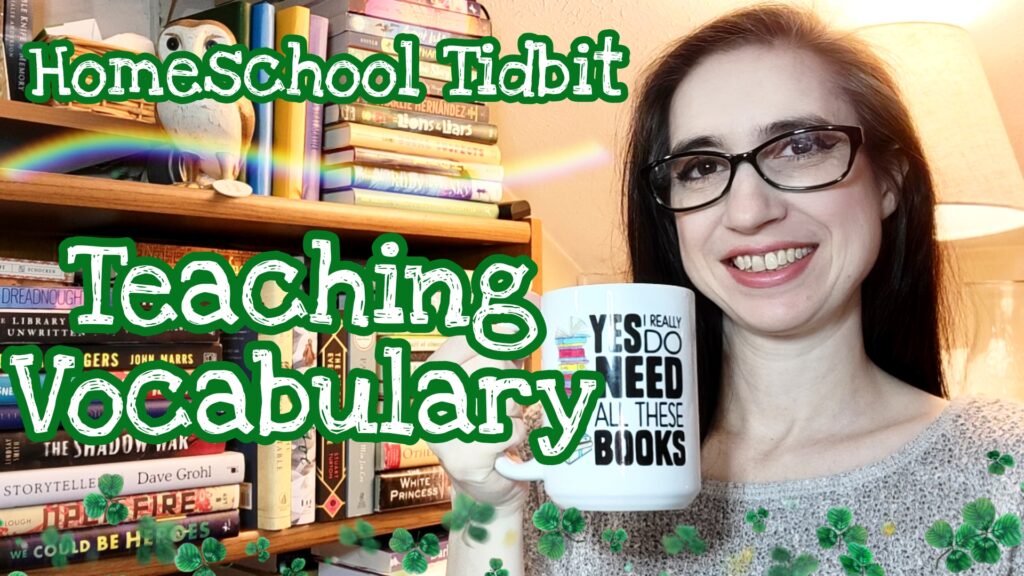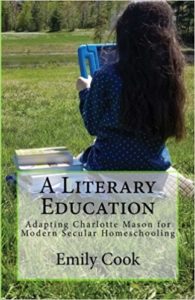Homeschool Tidbits: Teaching Vocabulary Painlessly
March 18, 2022
 Welcome to Build Your Library’s “Homeschool Tidbits: Episode 10 – Teaching Vocabulary Painlessly”. In this new weekly video series, I will delve briefly into a topic related to homeschooling and will share some of my knowledge and expertise as a long-time homeschooling mother of 4 children. Three of whom have graduated!
Welcome to Build Your Library’s “Homeschool Tidbits: Episode 10 – Teaching Vocabulary Painlessly”. In this new weekly video series, I will delve briefly into a topic related to homeschooling and will share some of my knowledge and expertise as a long-time homeschooling mother of 4 children. Three of whom have graduated!
Today we’re deviating a bit from our Charlotte Mason discussion to discuss a topic that comes up quite a lot. Vocabulary and how to teach it. Like picture study, this is something you can easily do without a curriculum. All you need is a well-stocked home library or a library card, and you are on your way to raising an articulate child!
How to Teach Vocabulary Organically
The first step to raising children with a wide vocabulary is to read. You should read to them, and they should read to themselves. Read alouds should be well-chosen books above their reading level. These will have a better vocabulary than the books they are able to read on their own. We’ve discussed living books at length, so if you want to know how to choose living books to read with your children, check out those videos.
The best way to learn vocabulary is by hearing words used repeatedly. This happens both in literature and in everyday language. Simply read together, and when you come across words in books that your child doesn’t know, add them to your regular daily chatter.
Enjoying your breakfast? Tell them it is scrumptious! Is it something beautiful? Say it’s ravishing, stunning, or exquisite! Just peppering your everyday conversation with big juicy words will embed them into their memory and you’ll start to hear them use them regularly as well! I’m a big believer in not talking down to children. So don’t be afraid to use big words with them. Talk about anything and everything! This will easily lead to giving your children a richer and more varied vocabulary.
Are you worried you don’t have a big enough vocabulary to do this? Never fear! Pick up a word of the day calendar or use the free Word of the Day from Merriam Webster Dictionary online and find ways to work those words into your daily dialogue.
What do I do with the Vocabulary Words that come with Build Your Library?
If you use Build Your Library or any literature-based homeschool curriculum, it comes with a list of vocabulary words from each day’s literature reading. You might feel like you need to do something with that list. But particularly if your children are young, resist the temptation to make that list into a lesson.
Rather, it is included for your benefit as the parent or learning mentor. As you read, and you come across a word that your child doesn’t know, they might interrupt to ask what it means. First, back up and read the sentence that contains the word again. Ask if they can guess the meaning based on context clues in that sentence. Learning language in context is an important skill that we should try to hone. I always give them a chance to figure it out on their own before sharing the definition. Once they have had a chance to think about it, they can take an educated guess. Then you can share the definition that is included in the lesson plans.
Maybe your child doesn’t want to interrupt to ask, that’s perfectly fine! Most kids won’t want to stop the story. You can either go over the words ahead of the reading or write them on a whiteboard so that they are listening for them. Pick one of them to add to your daily language. Make a point of using those words in your day-to-day talk. These new words will find their way into your child’s vocabulary with minimal effort on your part.
Charlotte Mason said: “We are convinced that they cannot understand a literary vocabulary so we explain and paraphrase to our own heart’s content but not to theirs…” So, avoid paraphrasing or dumbing down your language for your children.
Teaching Vocabulary with Older Children
As your children get older, you can let them take a more active role in their vocabulary study. Do they like to journal? You can use a simple notebook, or something fancier like this vocabulary journal created by a homeschool parent and Build Your Library user to study vocabulary words.
I like to ask my kids to keep their notebook nearby when they are reading. Then they can jot down words they come across in their reading to look up and study. We don’t do anything too formal. I usually ask them to look them up in the dictionary, and maybe use them in a sentence. We only do a formal study of a few words at a time, too much is overkill. I want to make this as much of a natural part of their reading as possible. Even I still have to look up a word once in a while. So I want them to realize that this is something that everyone does!
I’ve also included a vocabulary graphic organizer in the appendix of the upper levels of Build Your Library that you can use to do a formal study of vocabulary. It includes space for the definition, part of speech, synonyms, antonyms, a sentence, and more. There is a lot included, so don’t feel like you need to use that for every vocabulary word! Just one or two a day is plenty.
In the high school levels of Build Your Library, I no longer include definitions alongside the vocabulary. In the teen years, they are taking the reigns in their learning and I know some teens use the lesson plans independently. This list is for them to look at ahead of time to get an idea of vocabulary coming up in the reading. They can then choose to look up words they don’t know before they read or do it as they read.
More Vocabulary Tips
One of the benefits I’ve discovered of using an e-reader is that I can click on a word as I’m reading. Then it pulls up the definition for me right then and there! It’s a painless way to learn new vocabulary.
“I would have children taught to read before they learn the mechanical arts of reading and writing… A child does not lose by spending a couple of years in acquiring these because he is meanwhile “reading” the Bible, history, geography, tales, with close attention and a remarkable power of reproduction, or rather, of translation into his own language; he is acquiring a copious vocabulary and the habit of consecutive speech. In a word, he is an educated child from the first, and his power of dealing with books, with several books during the course of the morning’s “school,” increases with age.” – Charlotte Mason
With great literature and a learning companion willing to stretch their own vocabulary your child will be able to articulate their thoughts and pepper their daily conversation with a rich and varied vocabulary. And it will become a natural part of your day-to-day activities! Easy peasy!
Coming up next…
I hope you found this Tidbit helpful! Come back next week when we’ll be talking about Morning Baskets – or how to fit in all those fun odds and ends you have collected over the years!
Until next time, happy reading!
See Also:
Charlotte Mason in the Secular Homeschool
A Literary Education book
About Build Your Library
Homeschool Tidbits: Build Your Library’s Weekly Video Blog Series
 Emily Cook is the author and creator of the secular homeschool curriculum Build Your Library, a literature-based K-12 program infused with the teachings of Charlotte Mason. She writes full-year lesson plans as well as shorter topical unit studies. Emily has been homeschooling her four children in Southern NH for 21 years. She is passionate about reading aloud to children of all ages and loves to share her love of literature with others. She and her family also make incredibly dorky videos about homeschooling, books, and more on Youtube at ARRRGH! Schooling. You can follow her on Facebook, Twitter, and Pinterest. You can also check out her author page on Amazon.
Emily Cook is the author and creator of the secular homeschool curriculum Build Your Library, a literature-based K-12 program infused with the teachings of Charlotte Mason. She writes full-year lesson plans as well as shorter topical unit studies. Emily has been homeschooling her four children in Southern NH for 21 years. She is passionate about reading aloud to children of all ages and loves to share her love of literature with others. She and her family also make incredibly dorky videos about homeschooling, books, and more on Youtube at ARRRGH! Schooling. You can follow her on Facebook, Twitter, and Pinterest. You can also check out her author page on Amazon.
